Research Methodology: Corporate Power in a Global Market Essay
VerifiedAdded on 2023/03/17
|13
|3432
|71
Essay
AI Summary
This essay delves into the research methodology employed to investigate corporate power in the global market, focusing on its impact on economic activity and national sovereignty. The essay begins by acknowledging the significant influence corporations wield, shaping economic growth, political landscapes, and consumer behavior. It explores the dual nature of corporate power, highlighting its potential for economic advancement, job creation, and innovation, while also addressing concerns related to employee exploitation, environmental degradation, and market concentration. The essay then justifies the selection of a qualitative research methodology, emphasizing the use of secondary data sources such as journals, articles, and reports to analyze the complex dynamics of corporate power. It discusses the strengths of this approach, including its ability to provide in-depth insights and address complex topics, while also acknowledging potential weaknesses like the time-consuming nature of data collection and the susceptibility to researcher bias. The essay concludes by providing a comprehensive overview of the research process, illustrating the importance of ethical considerations and the careful interpretation of findings.
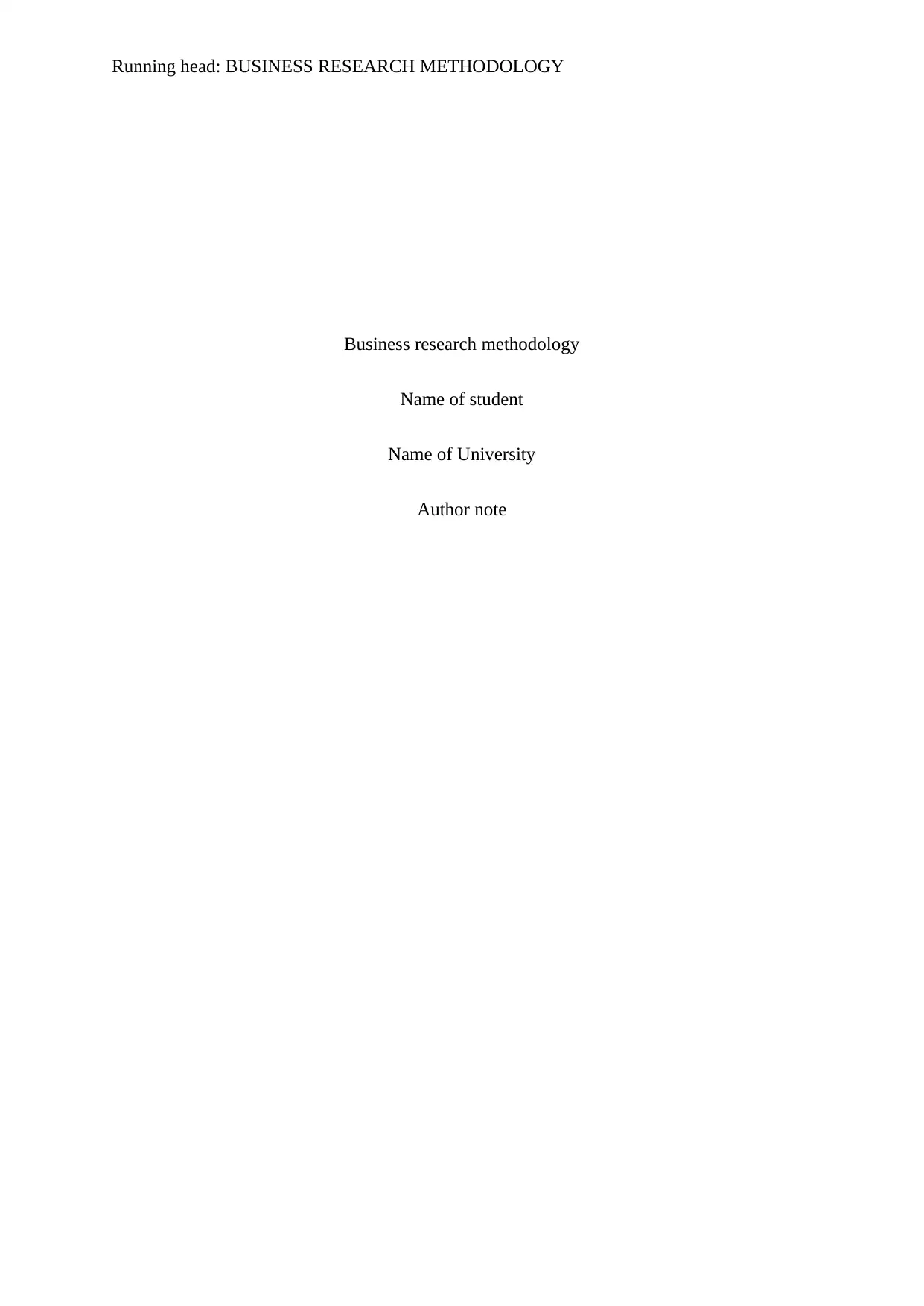
Running head: BUSINESS RESEARCH METHODOLOGY
Business research methodology
Name of student
Name of University
Author note
Business research methodology
Name of student
Name of University
Author note
Paraphrase This Document
Need a fresh take? Get an instant paraphrase of this document with our AI Paraphraser
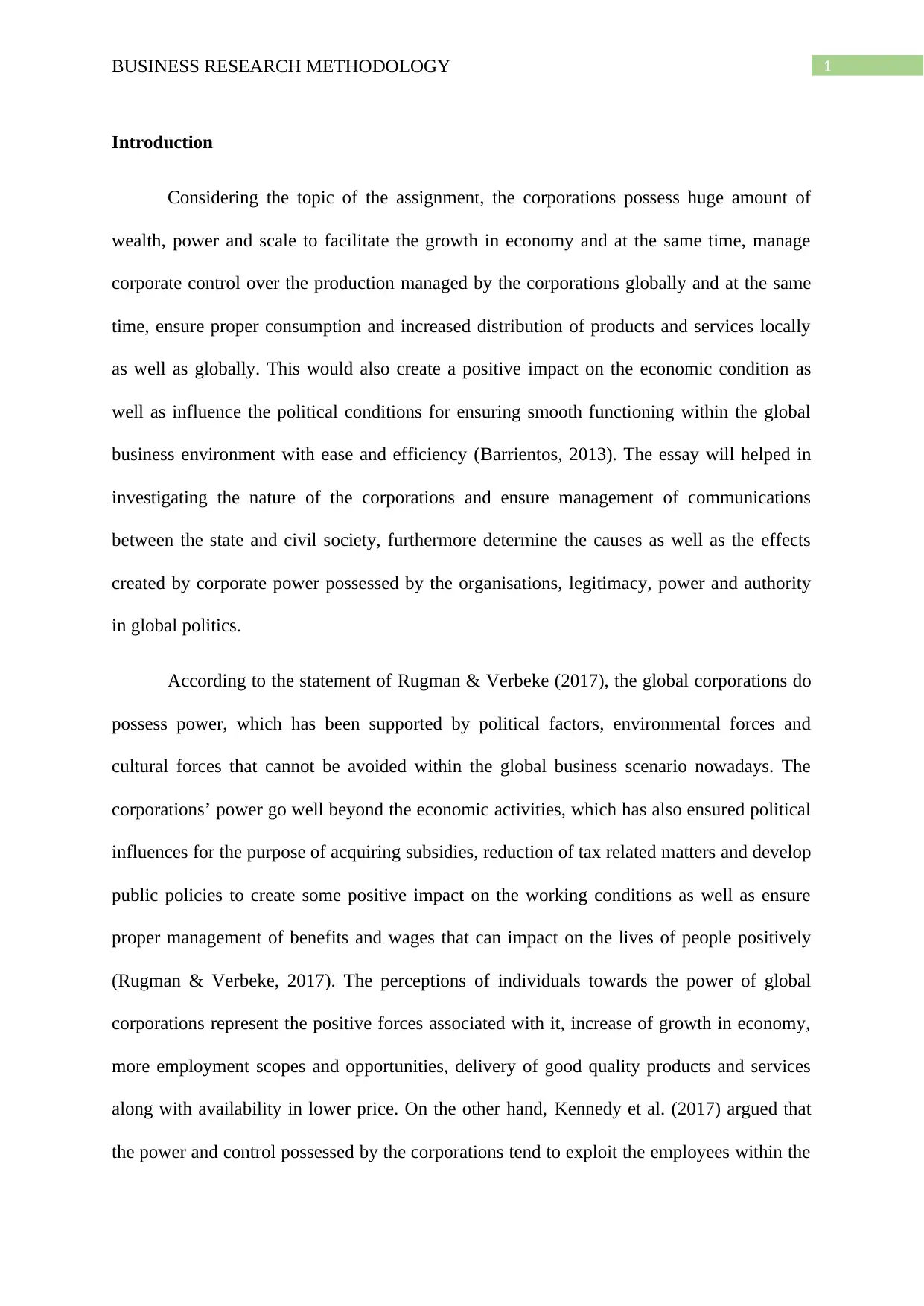
1BUSINESS RESEARCH METHODOLOGY
Introduction
Considering the topic of the assignment, the corporations possess huge amount of
wealth, power and scale to facilitate the growth in economy and at the same time, manage
corporate control over the production managed by the corporations globally and at the same
time, ensure proper consumption and increased distribution of products and services locally
as well as globally. This would also create a positive impact on the economic condition as
well as influence the political conditions for ensuring smooth functioning within the global
business environment with ease and efficiency (Barrientos, 2013). The essay will helped in
investigating the nature of the corporations and ensure management of communications
between the state and civil society, furthermore determine the causes as well as the effects
created by corporate power possessed by the organisations, legitimacy, power and authority
in global politics.
According to the statement of Rugman & Verbeke (2017), the global corporations do
possess power, which has been supported by political factors, environmental forces and
cultural forces that cannot be avoided within the global business scenario nowadays. The
corporations’ power go well beyond the economic activities, which has also ensured political
influences for the purpose of acquiring subsidies, reduction of tax related matters and develop
public policies to create some positive impact on the working conditions as well as ensure
proper management of benefits and wages that can impact on the lives of people positively
(Rugman & Verbeke, 2017). The perceptions of individuals towards the power of global
corporations represent the positive forces associated with it, increase of growth in economy,
more employment scopes and opportunities, delivery of good quality products and services
along with availability in lower price. On the other hand, Kennedy et al. (2017) argued that
the power and control possessed by the corporations tend to exploit the employees within the
Introduction
Considering the topic of the assignment, the corporations possess huge amount of
wealth, power and scale to facilitate the growth in economy and at the same time, manage
corporate control over the production managed by the corporations globally and at the same
time, ensure proper consumption and increased distribution of products and services locally
as well as globally. This would also create a positive impact on the economic condition as
well as influence the political conditions for ensuring smooth functioning within the global
business environment with ease and efficiency (Barrientos, 2013). The essay will helped in
investigating the nature of the corporations and ensure management of communications
between the state and civil society, furthermore determine the causes as well as the effects
created by corporate power possessed by the organisations, legitimacy, power and authority
in global politics.
According to the statement of Rugman & Verbeke (2017), the global corporations do
possess power, which has been supported by political factors, environmental forces and
cultural forces that cannot be avoided within the global business scenario nowadays. The
corporations’ power go well beyond the economic activities, which has also ensured political
influences for the purpose of acquiring subsidies, reduction of tax related matters and develop
public policies to create some positive impact on the working conditions as well as ensure
proper management of benefits and wages that can impact on the lives of people positively
(Rugman & Verbeke, 2017). The perceptions of individuals towards the power of global
corporations represent the positive forces associated with it, increase of growth in economy,
more employment scopes and opportunities, delivery of good quality products and services
along with availability in lower price. On the other hand, Kennedy et al. (2017) argued that
the power and control possessed by the corporations tend to exploit the employees within the
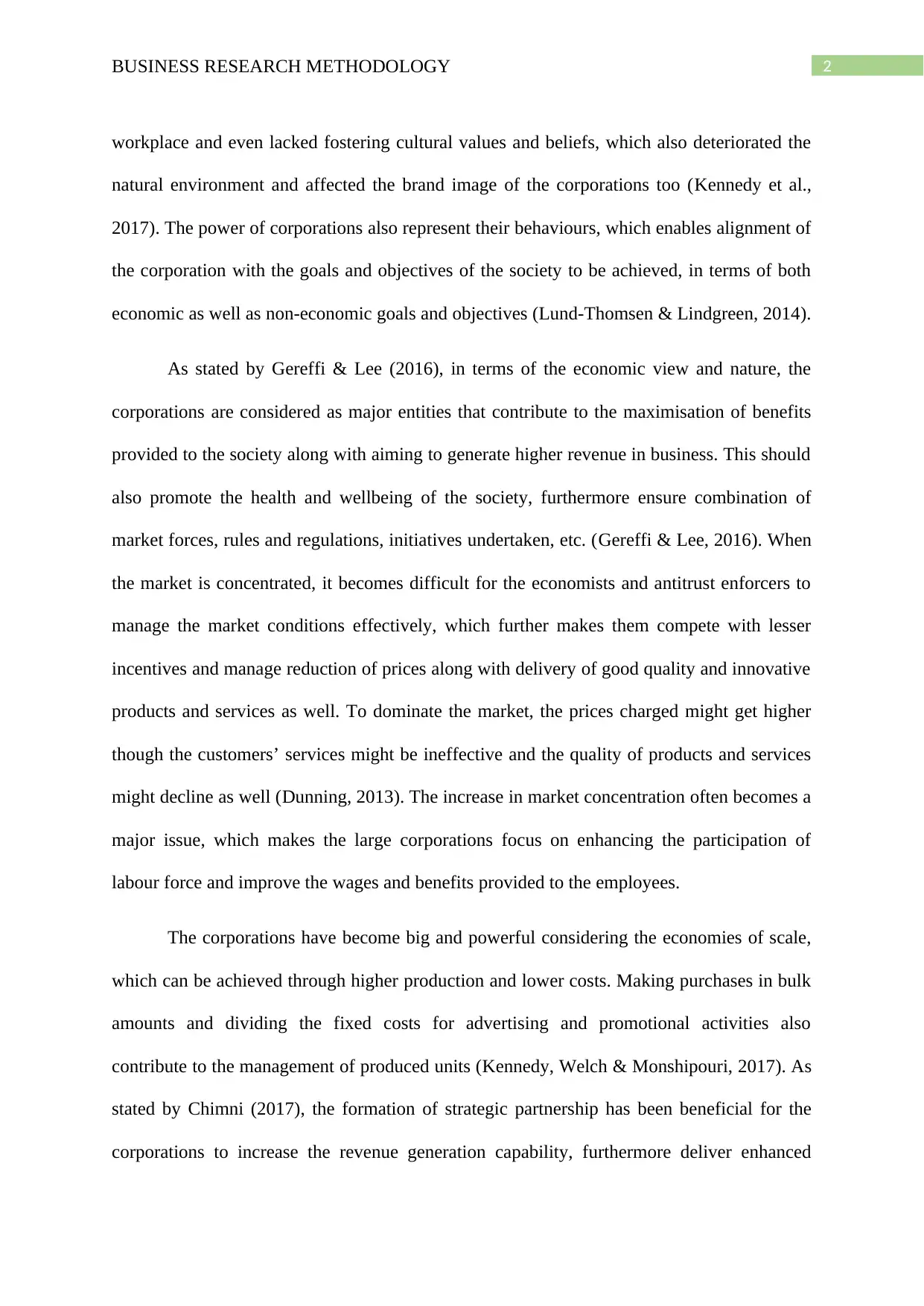
2BUSINESS RESEARCH METHODOLOGY
workplace and even lacked fostering cultural values and beliefs, which also deteriorated the
natural environment and affected the brand image of the corporations too (Kennedy et al.,
2017). The power of corporations also represent their behaviours, which enables alignment of
the corporation with the goals and objectives of the society to be achieved, in terms of both
economic as well as non-economic goals and objectives (Lund-Thomsen & Lindgreen, 2014).
As stated by Gereffi & Lee (2016), in terms of the economic view and nature, the
corporations are considered as major entities that contribute to the maximisation of benefits
provided to the society along with aiming to generate higher revenue in business. This should
also promote the health and wellbeing of the society, furthermore ensure combination of
market forces, rules and regulations, initiatives undertaken, etc. (Gereffi & Lee, 2016). When
the market is concentrated, it becomes difficult for the economists and antitrust enforcers to
manage the market conditions effectively, which further makes them compete with lesser
incentives and manage reduction of prices along with delivery of good quality and innovative
products and services as well. To dominate the market, the prices charged might get higher
though the customers’ services might be ineffective and the quality of products and services
might decline as well (Dunning, 2013). The increase in market concentration often becomes a
major issue, which makes the large corporations focus on enhancing the participation of
labour force and improve the wages and benefits provided to the employees.
The corporations have become big and powerful considering the economies of scale,
which can be achieved through higher production and lower costs. Making purchases in bulk
amounts and dividing the fixed costs for advertising and promotional activities also
contribute to the management of produced units (Kennedy, Welch & Monshipouri, 2017). As
stated by Chimni (2017), the formation of strategic partnership has been beneficial for the
corporations to increase the revenue generation capability, furthermore deliver enhanced
workplace and even lacked fostering cultural values and beliefs, which also deteriorated the
natural environment and affected the brand image of the corporations too (Kennedy et al.,
2017). The power of corporations also represent their behaviours, which enables alignment of
the corporation with the goals and objectives of the society to be achieved, in terms of both
economic as well as non-economic goals and objectives (Lund-Thomsen & Lindgreen, 2014).
As stated by Gereffi & Lee (2016), in terms of the economic view and nature, the
corporations are considered as major entities that contribute to the maximisation of benefits
provided to the society along with aiming to generate higher revenue in business. This should
also promote the health and wellbeing of the society, furthermore ensure combination of
market forces, rules and regulations, initiatives undertaken, etc. (Gereffi & Lee, 2016). When
the market is concentrated, it becomes difficult for the economists and antitrust enforcers to
manage the market conditions effectively, which further makes them compete with lesser
incentives and manage reduction of prices along with delivery of good quality and innovative
products and services as well. To dominate the market, the prices charged might get higher
though the customers’ services might be ineffective and the quality of products and services
might decline as well (Dunning, 2013). The increase in market concentration often becomes a
major issue, which makes the large corporations focus on enhancing the participation of
labour force and improve the wages and benefits provided to the employees.
The corporations have become big and powerful considering the economies of scale,
which can be achieved through higher production and lower costs. Making purchases in bulk
amounts and dividing the fixed costs for advertising and promotional activities also
contribute to the management of produced units (Kennedy, Welch & Monshipouri, 2017). As
stated by Chimni (2017), the formation of strategic partnership has been beneficial for the
corporations to increase the revenue generation capability, furthermore deliver enhanced
⊘ This is a preview!⊘
Do you want full access?
Subscribe today to unlock all pages.

Trusted by 1+ million students worldwide
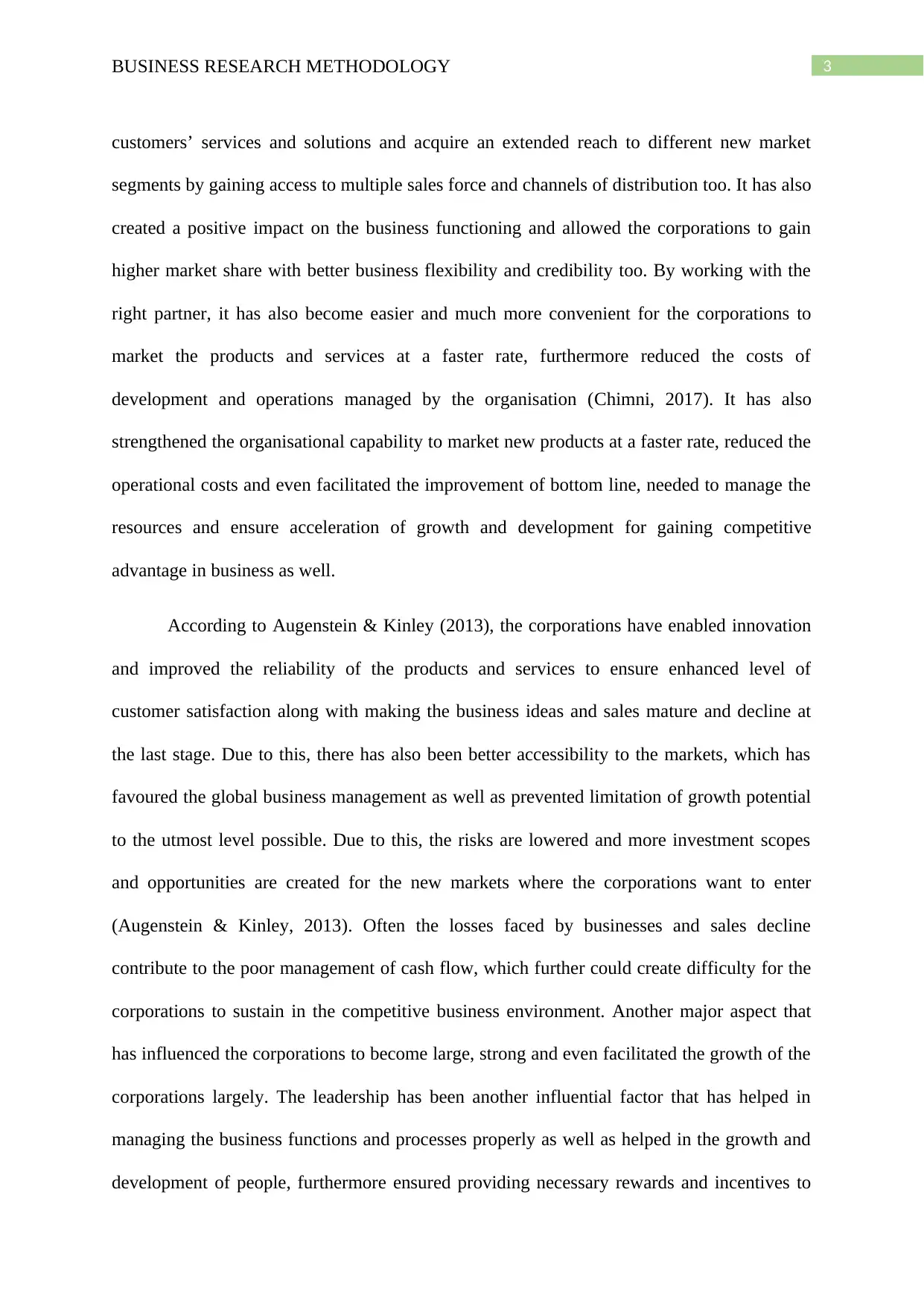
3BUSINESS RESEARCH METHODOLOGY
customers’ services and solutions and acquire an extended reach to different new market
segments by gaining access to multiple sales force and channels of distribution too. It has also
created a positive impact on the business functioning and allowed the corporations to gain
higher market share with better business flexibility and credibility too. By working with the
right partner, it has also become easier and much more convenient for the corporations to
market the products and services at a faster rate, furthermore reduced the costs of
development and operations managed by the organisation (Chimni, 2017). It has also
strengthened the organisational capability to market new products at a faster rate, reduced the
operational costs and even facilitated the improvement of bottom line, needed to manage the
resources and ensure acceleration of growth and development for gaining competitive
advantage in business as well.
According to Augenstein & Kinley (2013), the corporations have enabled innovation
and improved the reliability of the products and services to ensure enhanced level of
customer satisfaction along with making the business ideas and sales mature and decline at
the last stage. Due to this, there has also been better accessibility to the markets, which has
favoured the global business management as well as prevented limitation of growth potential
to the utmost level possible. Due to this, the risks are lowered and more investment scopes
and opportunities are created for the new markets where the corporations want to enter
(Augenstein & Kinley, 2013). Often the losses faced by businesses and sales decline
contribute to the poor management of cash flow, which further could create difficulty for the
corporations to sustain in the competitive business environment. Another major aspect that
has influenced the corporations to become large, strong and even facilitated the growth of the
corporations largely. The leadership has been another influential factor that has helped in
managing the business functions and processes properly as well as helped in the growth and
development of people, furthermore ensured providing necessary rewards and incentives to
customers’ services and solutions and acquire an extended reach to different new market
segments by gaining access to multiple sales force and channels of distribution too. It has also
created a positive impact on the business functioning and allowed the corporations to gain
higher market share with better business flexibility and credibility too. By working with the
right partner, it has also become easier and much more convenient for the corporations to
market the products and services at a faster rate, furthermore reduced the costs of
development and operations managed by the organisation (Chimni, 2017). It has also
strengthened the organisational capability to market new products at a faster rate, reduced the
operational costs and even facilitated the improvement of bottom line, needed to manage the
resources and ensure acceleration of growth and development for gaining competitive
advantage in business as well.
According to Augenstein & Kinley (2013), the corporations have enabled innovation
and improved the reliability of the products and services to ensure enhanced level of
customer satisfaction along with making the business ideas and sales mature and decline at
the last stage. Due to this, there has also been better accessibility to the markets, which has
favoured the global business management as well as prevented limitation of growth potential
to the utmost level possible. Due to this, the risks are lowered and more investment scopes
and opportunities are created for the new markets where the corporations want to enter
(Augenstein & Kinley, 2013). Often the losses faced by businesses and sales decline
contribute to the poor management of cash flow, which further could create difficulty for the
corporations to sustain in the competitive business environment. Another major aspect that
has influenced the corporations to become large, strong and even facilitated the growth of the
corporations largely. The leadership has been another influential factor that has helped in
managing the business functions and processes properly as well as helped in the growth and
development of people, furthermore ensured providing necessary rewards and incentives to
Paraphrase This Document
Need a fresh take? Get an instant paraphrase of this document with our AI Paraphraser
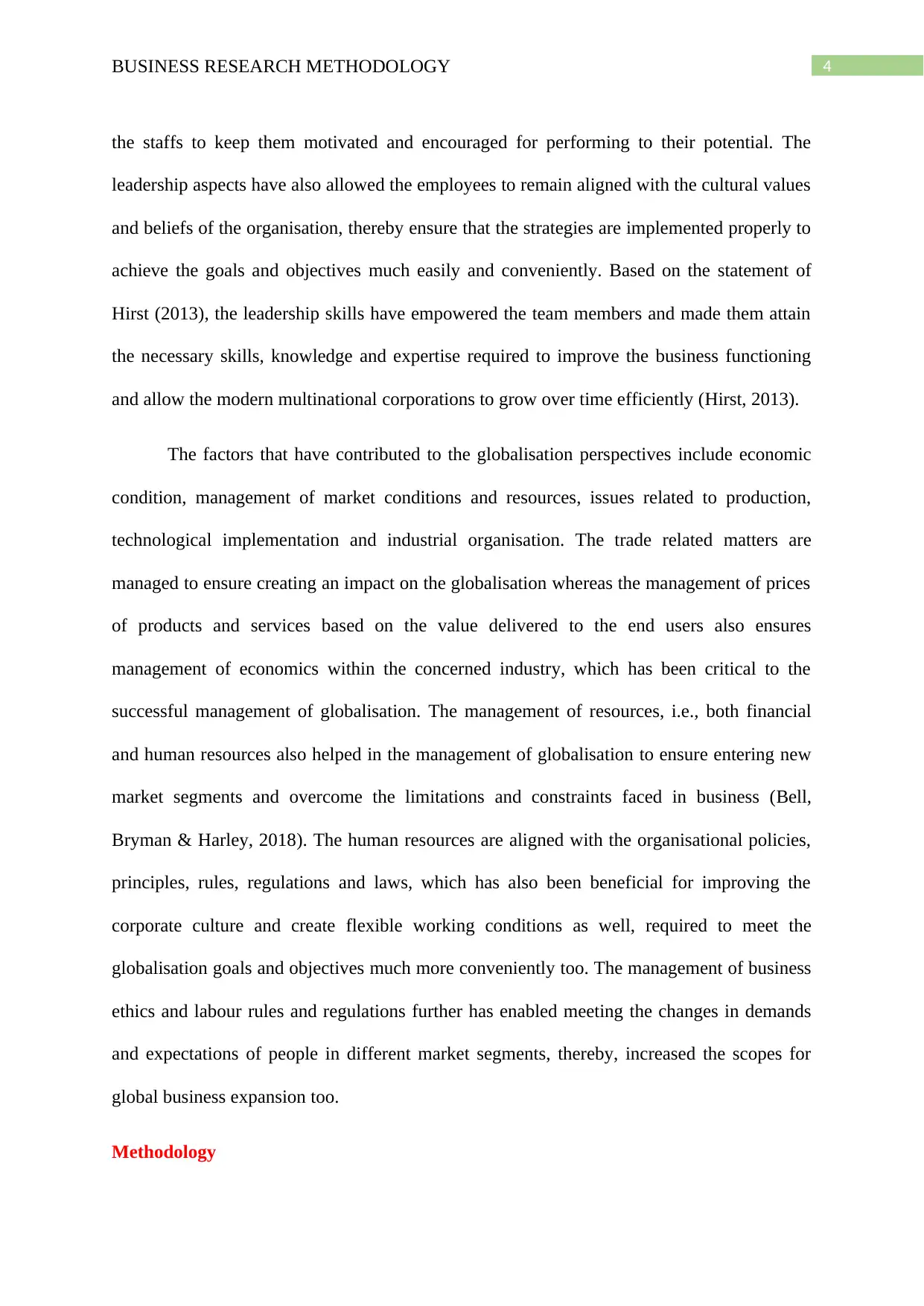
4BUSINESS RESEARCH METHODOLOGY
the staffs to keep them motivated and encouraged for performing to their potential. The
leadership aspects have also allowed the employees to remain aligned with the cultural values
and beliefs of the organisation, thereby ensure that the strategies are implemented properly to
achieve the goals and objectives much easily and conveniently. Based on the statement of
Hirst (2013), the leadership skills have empowered the team members and made them attain
the necessary skills, knowledge and expertise required to improve the business functioning
and allow the modern multinational corporations to grow over time efficiently (Hirst, 2013).
The factors that have contributed to the globalisation perspectives include economic
condition, management of market conditions and resources, issues related to production,
technological implementation and industrial organisation. The trade related matters are
managed to ensure creating an impact on the globalisation whereas the management of prices
of products and services based on the value delivered to the end users also ensures
management of economics within the concerned industry, which has been critical to the
successful management of globalisation. The management of resources, i.e., both financial
and human resources also helped in the management of globalisation to ensure entering new
market segments and overcome the limitations and constraints faced in business (Bell,
Bryman & Harley, 2018). The human resources are aligned with the organisational policies,
principles, rules, regulations and laws, which has also been beneficial for improving the
corporate culture and create flexible working conditions as well, required to meet the
globalisation goals and objectives much more conveniently too. The management of business
ethics and labour rules and regulations further has enabled meeting the changes in demands
and expectations of people in different market segments, thereby, increased the scopes for
global business expansion too.
Methodology
the staffs to keep them motivated and encouraged for performing to their potential. The
leadership aspects have also allowed the employees to remain aligned with the cultural values
and beliefs of the organisation, thereby ensure that the strategies are implemented properly to
achieve the goals and objectives much easily and conveniently. Based on the statement of
Hirst (2013), the leadership skills have empowered the team members and made them attain
the necessary skills, knowledge and expertise required to improve the business functioning
and allow the modern multinational corporations to grow over time efficiently (Hirst, 2013).
The factors that have contributed to the globalisation perspectives include economic
condition, management of market conditions and resources, issues related to production,
technological implementation and industrial organisation. The trade related matters are
managed to ensure creating an impact on the globalisation whereas the management of prices
of products and services based on the value delivered to the end users also ensures
management of economics within the concerned industry, which has been critical to the
successful management of globalisation. The management of resources, i.e., both financial
and human resources also helped in the management of globalisation to ensure entering new
market segments and overcome the limitations and constraints faced in business (Bell,
Bryman & Harley, 2018). The human resources are aligned with the organisational policies,
principles, rules, regulations and laws, which has also been beneficial for improving the
corporate culture and create flexible working conditions as well, required to meet the
globalisation goals and objectives much more conveniently too. The management of business
ethics and labour rules and regulations further has enabled meeting the changes in demands
and expectations of people in different market segments, thereby, increased the scopes for
global business expansion too.
Methodology
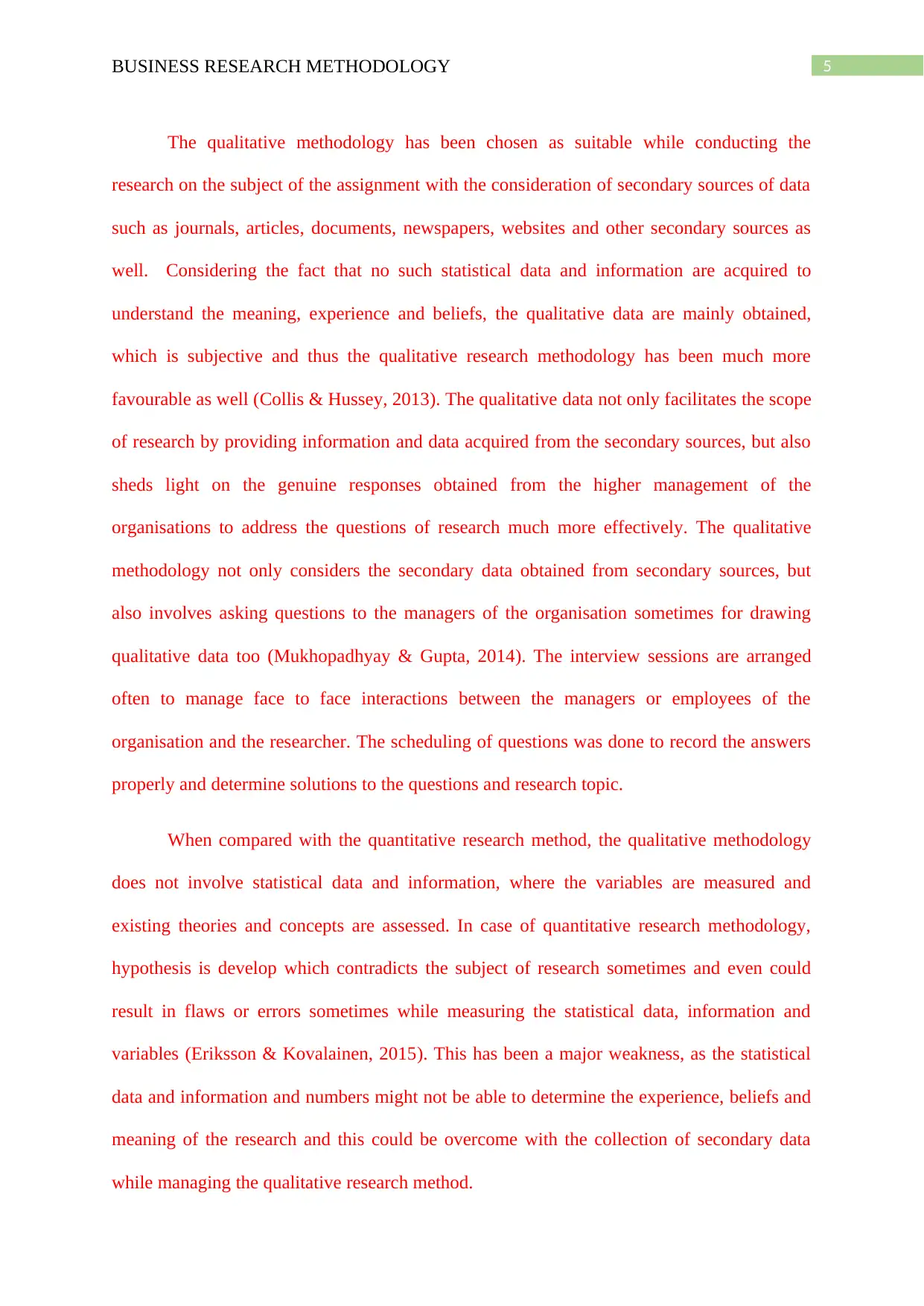
5BUSINESS RESEARCH METHODOLOGY
The qualitative methodology has been chosen as suitable while conducting the
research on the subject of the assignment with the consideration of secondary sources of data
such as journals, articles, documents, newspapers, websites and other secondary sources as
well. Considering the fact that no such statistical data and information are acquired to
understand the meaning, experience and beliefs, the qualitative data are mainly obtained,
which is subjective and thus the qualitative research methodology has been much more
favourable as well (Collis & Hussey, 2013). The qualitative data not only facilitates the scope
of research by providing information and data acquired from the secondary sources, but also
sheds light on the genuine responses obtained from the higher management of the
organisations to address the questions of research much more effectively. The qualitative
methodology not only considers the secondary data obtained from secondary sources, but
also involves asking questions to the managers of the organisation sometimes for drawing
qualitative data too (Mukhopadhyay & Gupta, 2014). The interview sessions are arranged
often to manage face to face interactions between the managers or employees of the
organisation and the researcher. The scheduling of questions was done to record the answers
properly and determine solutions to the questions and research topic.
When compared with the quantitative research method, the qualitative methodology
does not involve statistical data and information, where the variables are measured and
existing theories and concepts are assessed. In case of quantitative research methodology,
hypothesis is develop which contradicts the subject of research sometimes and even could
result in flaws or errors sometimes while measuring the statistical data, information and
variables (Eriksson & Kovalainen, 2015). This has been a major weakness, as the statistical
data and information and numbers might not be able to determine the experience, beliefs and
meaning of the research and this could be overcome with the collection of secondary data
while managing the qualitative research method.
The qualitative methodology has been chosen as suitable while conducting the
research on the subject of the assignment with the consideration of secondary sources of data
such as journals, articles, documents, newspapers, websites and other secondary sources as
well. Considering the fact that no such statistical data and information are acquired to
understand the meaning, experience and beliefs, the qualitative data are mainly obtained,
which is subjective and thus the qualitative research methodology has been much more
favourable as well (Collis & Hussey, 2013). The qualitative data not only facilitates the scope
of research by providing information and data acquired from the secondary sources, but also
sheds light on the genuine responses obtained from the higher management of the
organisations to address the questions of research much more effectively. The qualitative
methodology not only considers the secondary data obtained from secondary sources, but
also involves asking questions to the managers of the organisation sometimes for drawing
qualitative data too (Mukhopadhyay & Gupta, 2014). The interview sessions are arranged
often to manage face to face interactions between the managers or employees of the
organisation and the researcher. The scheduling of questions was done to record the answers
properly and determine solutions to the questions and research topic.
When compared with the quantitative research method, the qualitative methodology
does not involve statistical data and information, where the variables are measured and
existing theories and concepts are assessed. In case of quantitative research methodology,
hypothesis is develop which contradicts the subject of research sometimes and even could
result in flaws or errors sometimes while measuring the statistical data, information and
variables (Eriksson & Kovalainen, 2015). This has been a major weakness, as the statistical
data and information and numbers might not be able to determine the experience, beliefs and
meaning of the research and this could be overcome with the collection of secondary data
while managing the qualitative research method.
⊘ This is a preview!⊘
Do you want full access?
Subscribe today to unlock all pages.

Trusted by 1+ million students worldwide

6BUSINESS RESEARCH METHODOLOGY
One of the major weaknesses could be the issues associated with the closed questions
asked during the interview sessions, which could limit the responses provided by the
interviewee, furthermore affect the deriving of research outcomes. In spite of the weaknesses,
the qualitative research methodology design has been the most effective, because of the
research study carefully designed and structured too. The qualitative methodology with the
consideration of secondary data has also helped in dealing with complex subjects as well as
created linear relationships between the different kinds of variables needed to gain in-sight
into the reasons and patterns of the phenomena. Another major strength of the qualitative
research methodology is that it has not been dependent upon the sample size consideration,
which is mainly preferred while selecting the quantitative sampling method (Myers, 2013).
The secondary sources of data from which data and information have been collected to
constitute the literature review are present in large numbers, which are easily accessible and
also can be related to the research components to develop link between the research variables
much more conveniently. Thus, the qualitative research method has been considered .as
effective and reliable here (Taylor et al., 2015).
When compared to the quantitative method, the qualitative research method has some
major drawbacks too such as the high amount of time and huge amount of resources
consumed. The quantitative research method resolves around the management of survey
questionnaires, which can be completed within quick time whereas for qualitative data
collection, interviews are conducted and questions are asked, which is quite time consuming.
A lot of effort should be put to carefully think and plan for the study to deal with the ethical
issues of the research (Jamshed, 2014). The researcher needs to be more sensitive to biasness
and philosophical aspects related to the questions addressed in the research topic. There is no
presence of statistical data and information and thus mathematical calculations and analysis
are not required, which can deteriorate the research findings and thus the data and
One of the major weaknesses could be the issues associated with the closed questions
asked during the interview sessions, which could limit the responses provided by the
interviewee, furthermore affect the deriving of research outcomes. In spite of the weaknesses,
the qualitative research methodology design has been the most effective, because of the
research study carefully designed and structured too. The qualitative methodology with the
consideration of secondary data has also helped in dealing with complex subjects as well as
created linear relationships between the different kinds of variables needed to gain in-sight
into the reasons and patterns of the phenomena. Another major strength of the qualitative
research methodology is that it has not been dependent upon the sample size consideration,
which is mainly preferred while selecting the quantitative sampling method (Myers, 2013).
The secondary sources of data from which data and information have been collected to
constitute the literature review are present in large numbers, which are easily accessible and
also can be related to the research components to develop link between the research variables
much more conveniently. Thus, the qualitative research method has been considered .as
effective and reliable here (Taylor et al., 2015).
When compared to the quantitative method, the qualitative research method has some
major drawbacks too such as the high amount of time and huge amount of resources
consumed. The quantitative research method resolves around the management of survey
questionnaires, which can be completed within quick time whereas for qualitative data
collection, interviews are conducted and questions are asked, which is quite time consuming.
A lot of effort should be put to carefully think and plan for the study to deal with the ethical
issues of the research (Jamshed, 2014). The researcher needs to be more sensitive to biasness
and philosophical aspects related to the questions addressed in the research topic. There is no
presence of statistical data and information and thus mathematical calculations and analysis
are not required, which can deteriorate the research findings and thus the data and
Paraphrase This Document
Need a fresh take? Get an instant paraphrase of this document with our AI Paraphraser
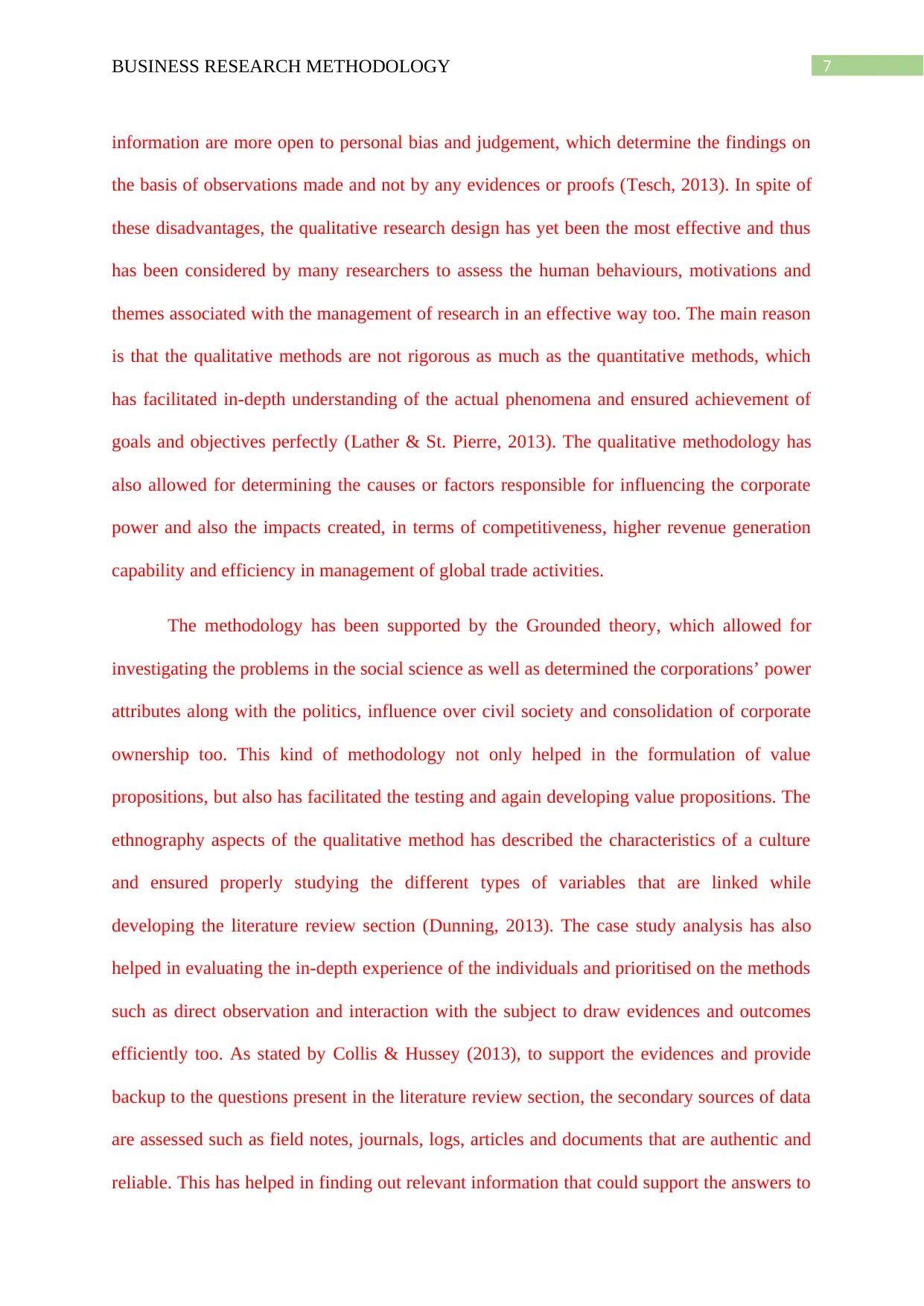
7BUSINESS RESEARCH METHODOLOGY
information are more open to personal bias and judgement, which determine the findings on
the basis of observations made and not by any evidences or proofs (Tesch, 2013). In spite of
these disadvantages, the qualitative research design has yet been the most effective and thus
has been considered by many researchers to assess the human behaviours, motivations and
themes associated with the management of research in an effective way too. The main reason
is that the qualitative methods are not rigorous as much as the quantitative methods, which
has facilitated in-depth understanding of the actual phenomena and ensured achievement of
goals and objectives perfectly (Lather & St. Pierre, 2013). The qualitative methodology has
also allowed for determining the causes or factors responsible for influencing the corporate
power and also the impacts created, in terms of competitiveness, higher revenue generation
capability and efficiency in management of global trade activities.
The methodology has been supported by the Grounded theory, which allowed for
investigating the problems in the social science as well as determined the corporations’ power
attributes along with the politics, influence over civil society and consolidation of corporate
ownership too. This kind of methodology not only helped in the formulation of value
propositions, but also has facilitated the testing and again developing value propositions. The
ethnography aspects of the qualitative method has described the characteristics of a culture
and ensured properly studying the different types of variables that are linked while
developing the literature review section (Dunning, 2013). The case study analysis has also
helped in evaluating the in-depth experience of the individuals and prioritised on the methods
such as direct observation and interaction with the subject to draw evidences and outcomes
efficiently too. As stated by Collis & Hussey (2013), to support the evidences and provide
backup to the questions present in the literature review section, the secondary sources of data
are assessed such as field notes, journals, logs, articles and documents that are authentic and
reliable. This has helped in finding out relevant information that could support the answers to
information are more open to personal bias and judgement, which determine the findings on
the basis of observations made and not by any evidences or proofs (Tesch, 2013). In spite of
these disadvantages, the qualitative research design has yet been the most effective and thus
has been considered by many researchers to assess the human behaviours, motivations and
themes associated with the management of research in an effective way too. The main reason
is that the qualitative methods are not rigorous as much as the quantitative methods, which
has facilitated in-depth understanding of the actual phenomena and ensured achievement of
goals and objectives perfectly (Lather & St. Pierre, 2013). The qualitative methodology has
also allowed for determining the causes or factors responsible for influencing the corporate
power and also the impacts created, in terms of competitiveness, higher revenue generation
capability and efficiency in management of global trade activities.
The methodology has been supported by the Grounded theory, which allowed for
investigating the problems in the social science as well as determined the corporations’ power
attributes along with the politics, influence over civil society and consolidation of corporate
ownership too. This kind of methodology not only helped in the formulation of value
propositions, but also has facilitated the testing and again developing value propositions. The
ethnography aspects of the qualitative method has described the characteristics of a culture
and ensured properly studying the different types of variables that are linked while
developing the literature review section (Dunning, 2013). The case study analysis has also
helped in evaluating the in-depth experience of the individuals and prioritised on the methods
such as direct observation and interaction with the subject to draw evidences and outcomes
efficiently too. As stated by Collis & Hussey (2013), to support the evidences and provide
backup to the questions present in the literature review section, the secondary sources of data
are assessed such as field notes, journals, logs, articles and documents that are authentic and
reliable. This has helped in finding out relevant information that could support the answers to
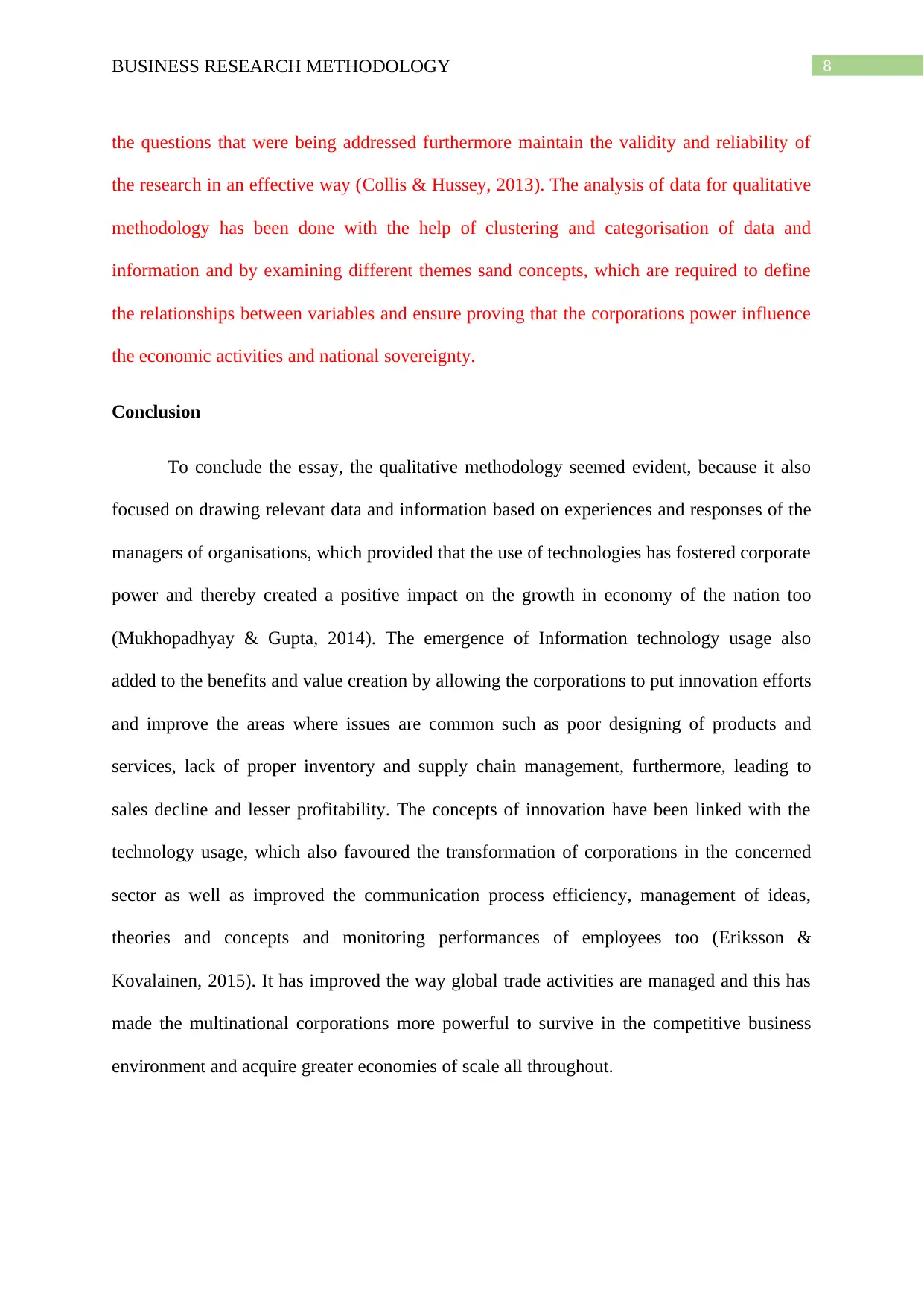
8BUSINESS RESEARCH METHODOLOGY
the questions that were being addressed furthermore maintain the validity and reliability of
the research in an effective way (Collis & Hussey, 2013). The analysis of data for qualitative
methodology has been done with the help of clustering and categorisation of data and
information and by examining different themes sand concepts, which are required to define
the relationships between variables and ensure proving that the corporations power influence
the economic activities and national sovereignty.
Conclusion
To conclude the essay, the qualitative methodology seemed evident, because it also
focused on drawing relevant data and information based on experiences and responses of the
managers of organisations, which provided that the use of technologies has fostered corporate
power and thereby created a positive impact on the growth in economy of the nation too
(Mukhopadhyay & Gupta, 2014). The emergence of Information technology usage also
added to the benefits and value creation by allowing the corporations to put innovation efforts
and improve the areas where issues are common such as poor designing of products and
services, lack of proper inventory and supply chain management, furthermore, leading to
sales decline and lesser profitability. The concepts of innovation have been linked with the
technology usage, which also favoured the transformation of corporations in the concerned
sector as well as improved the communication process efficiency, management of ideas,
theories and concepts and monitoring performances of employees too (Eriksson &
Kovalainen, 2015). It has improved the way global trade activities are managed and this has
made the multinational corporations more powerful to survive in the competitive business
environment and acquire greater economies of scale all throughout.
the questions that were being addressed furthermore maintain the validity and reliability of
the research in an effective way (Collis & Hussey, 2013). The analysis of data for qualitative
methodology has been done with the help of clustering and categorisation of data and
information and by examining different themes sand concepts, which are required to define
the relationships between variables and ensure proving that the corporations power influence
the economic activities and national sovereignty.
Conclusion
To conclude the essay, the qualitative methodology seemed evident, because it also
focused on drawing relevant data and information based on experiences and responses of the
managers of organisations, which provided that the use of technologies has fostered corporate
power and thereby created a positive impact on the growth in economy of the nation too
(Mukhopadhyay & Gupta, 2014). The emergence of Information technology usage also
added to the benefits and value creation by allowing the corporations to put innovation efforts
and improve the areas where issues are common such as poor designing of products and
services, lack of proper inventory and supply chain management, furthermore, leading to
sales decline and lesser profitability. The concepts of innovation have been linked with the
technology usage, which also favoured the transformation of corporations in the concerned
sector as well as improved the communication process efficiency, management of ideas,
theories and concepts and monitoring performances of employees too (Eriksson &
Kovalainen, 2015). It has improved the way global trade activities are managed and this has
made the multinational corporations more powerful to survive in the competitive business
environment and acquire greater economies of scale all throughout.
⊘ This is a preview!⊘
Do you want full access?
Subscribe today to unlock all pages.

Trusted by 1+ million students worldwide
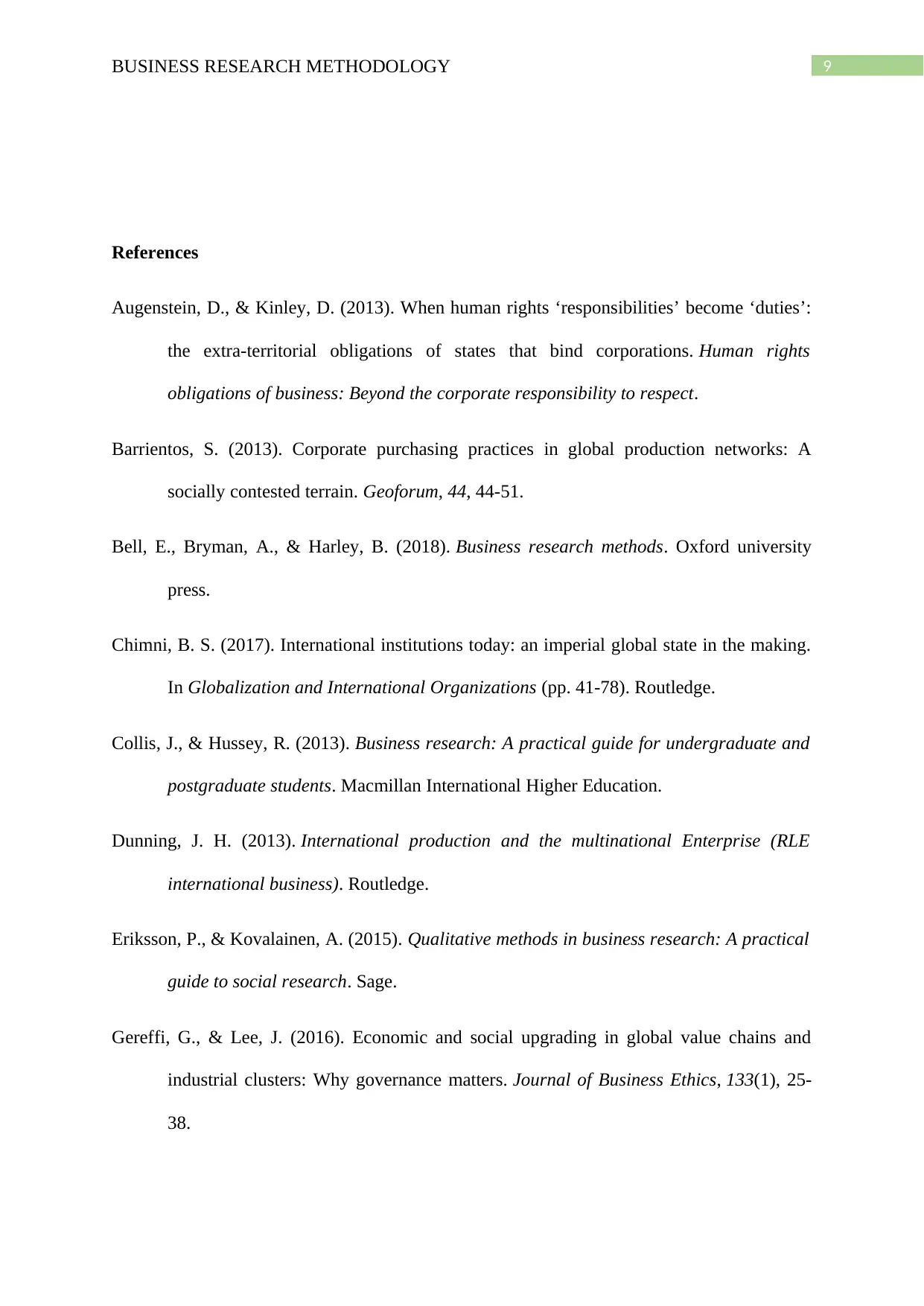
9BUSINESS RESEARCH METHODOLOGY
References
Augenstein, D., & Kinley, D. (2013). When human rights ‘responsibilities’ become ‘duties’:
the extra-territorial obligations of states that bind corporations. Human rights
obligations of business: Beyond the corporate responsibility to respect.
Barrientos, S. (2013). Corporate purchasing practices in global production networks: A
socially contested terrain. Geoforum, 44, 44-51.
Bell, E., Bryman, A., & Harley, B. (2018). Business research methods. Oxford university
press.
Chimni, B. S. (2017). International institutions today: an imperial global state in the making.
In Globalization and International Organizations (pp. 41-78). Routledge.
Collis, J., & Hussey, R. (2013). Business research: A practical guide for undergraduate and
postgraduate students. Macmillan International Higher Education.
Dunning, J. H. (2013). International production and the multinational Enterprise (RLE
international business). Routledge.
Eriksson, P., & Kovalainen, A. (2015). Qualitative methods in business research: A practical
guide to social research. Sage.
Gereffi, G., & Lee, J. (2016). Economic and social upgrading in global value chains and
industrial clusters: Why governance matters. Journal of Business Ethics, 133(1), 25-
38.
References
Augenstein, D., & Kinley, D. (2013). When human rights ‘responsibilities’ become ‘duties’:
the extra-territorial obligations of states that bind corporations. Human rights
obligations of business: Beyond the corporate responsibility to respect.
Barrientos, S. (2013). Corporate purchasing practices in global production networks: A
socially contested terrain. Geoforum, 44, 44-51.
Bell, E., Bryman, A., & Harley, B. (2018). Business research methods. Oxford university
press.
Chimni, B. S. (2017). International institutions today: an imperial global state in the making.
In Globalization and International Organizations (pp. 41-78). Routledge.
Collis, J., & Hussey, R. (2013). Business research: A practical guide for undergraduate and
postgraduate students. Macmillan International Higher Education.
Dunning, J. H. (2013). International production and the multinational Enterprise (RLE
international business). Routledge.
Eriksson, P., & Kovalainen, A. (2015). Qualitative methods in business research: A practical
guide to social research. Sage.
Gereffi, G., & Lee, J. (2016). Economic and social upgrading in global value chains and
industrial clusters: Why governance matters. Journal of Business Ethics, 133(1), 25-
38.
Paraphrase This Document
Need a fresh take? Get an instant paraphrase of this document with our AI Paraphraser
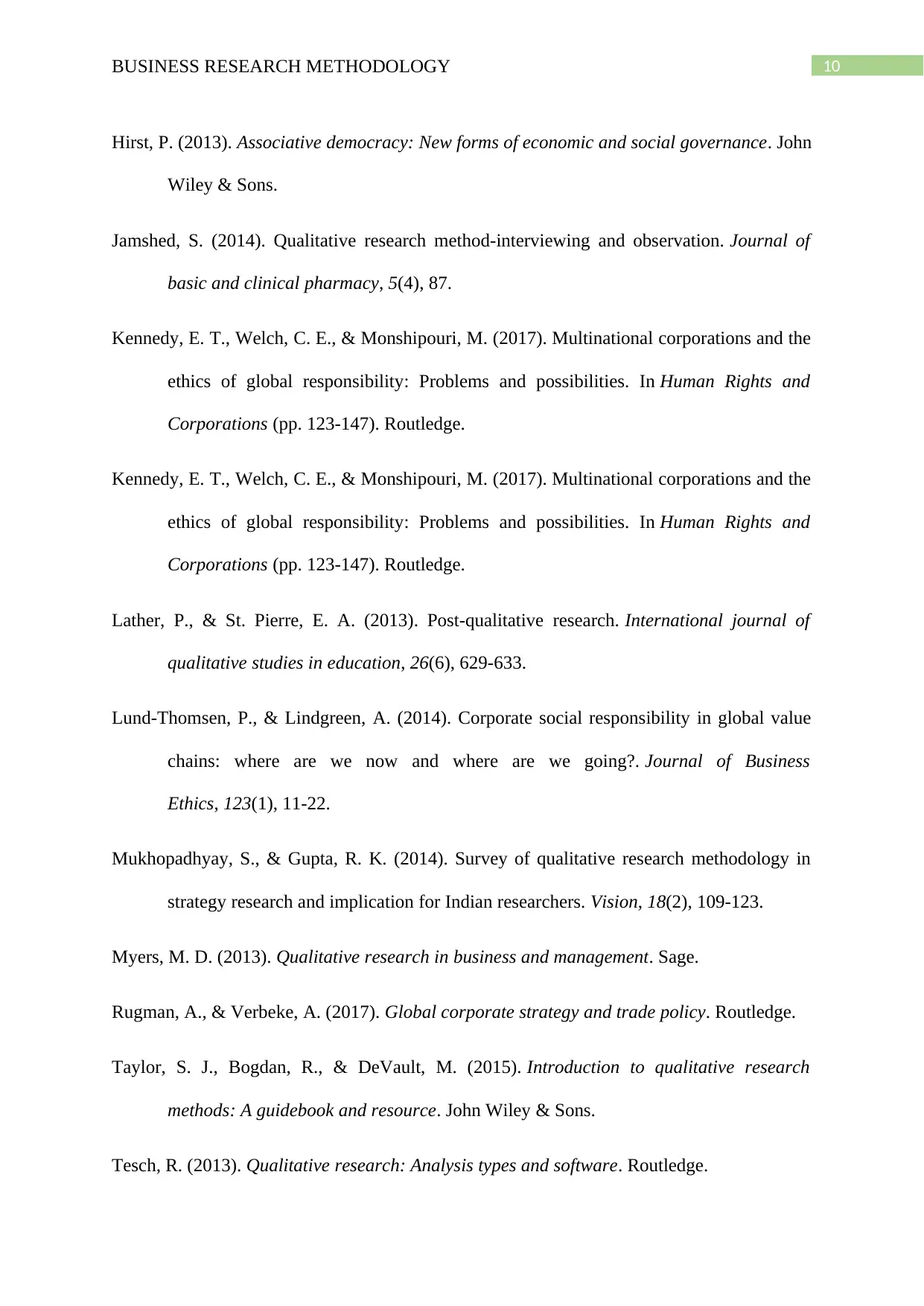
10BUSINESS RESEARCH METHODOLOGY
Hirst, P. (2013). Associative democracy: New forms of economic and social governance. John
Wiley & Sons.
Jamshed, S. (2014). Qualitative research method-interviewing and observation. Journal of
basic and clinical pharmacy, 5(4), 87.
Kennedy, E. T., Welch, C. E., & Monshipouri, M. (2017). Multinational corporations and the
ethics of global responsibility: Problems and possibilities. In Human Rights and
Corporations (pp. 123-147). Routledge.
Kennedy, E. T., Welch, C. E., & Monshipouri, M. (2017). Multinational corporations and the
ethics of global responsibility: Problems and possibilities. In Human Rights and
Corporations (pp. 123-147). Routledge.
Lather, P., & St. Pierre, E. A. (2013). Post-qualitative research. International journal of
qualitative studies in education, 26(6), 629-633.
Lund-Thomsen, P., & Lindgreen, A. (2014). Corporate social responsibility in global value
chains: where are we now and where are we going?. Journal of Business
Ethics, 123(1), 11-22.
Mukhopadhyay, S., & Gupta, R. K. (2014). Survey of qualitative research methodology in
strategy research and implication for Indian researchers. Vision, 18(2), 109-123.
Myers, M. D. (2013). Qualitative research in business and management. Sage.
Rugman, A., & Verbeke, A. (2017). Global corporate strategy and trade policy. Routledge.
Taylor, S. J., Bogdan, R., & DeVault, M. (2015). Introduction to qualitative research
methods: A guidebook and resource. John Wiley & Sons.
Tesch, R. (2013). Qualitative research: Analysis types and software. Routledge.
Hirst, P. (2013). Associative democracy: New forms of economic and social governance. John
Wiley & Sons.
Jamshed, S. (2014). Qualitative research method-interviewing and observation. Journal of
basic and clinical pharmacy, 5(4), 87.
Kennedy, E. T., Welch, C. E., & Monshipouri, M. (2017). Multinational corporations and the
ethics of global responsibility: Problems and possibilities. In Human Rights and
Corporations (pp. 123-147). Routledge.
Kennedy, E. T., Welch, C. E., & Monshipouri, M. (2017). Multinational corporations and the
ethics of global responsibility: Problems and possibilities. In Human Rights and
Corporations (pp. 123-147). Routledge.
Lather, P., & St. Pierre, E. A. (2013). Post-qualitative research. International journal of
qualitative studies in education, 26(6), 629-633.
Lund-Thomsen, P., & Lindgreen, A. (2014). Corporate social responsibility in global value
chains: where are we now and where are we going?. Journal of Business
Ethics, 123(1), 11-22.
Mukhopadhyay, S., & Gupta, R. K. (2014). Survey of qualitative research methodology in
strategy research and implication for Indian researchers. Vision, 18(2), 109-123.
Myers, M. D. (2013). Qualitative research in business and management. Sage.
Rugman, A., & Verbeke, A. (2017). Global corporate strategy and trade policy. Routledge.
Taylor, S. J., Bogdan, R., & DeVault, M. (2015). Introduction to qualitative research
methods: A guidebook and resource. John Wiley & Sons.
Tesch, R. (2013). Qualitative research: Analysis types and software. Routledge.

11BUSINESS RESEARCH METHODOLOGY
⊘ This is a preview!⊘
Do you want full access?
Subscribe today to unlock all pages.

Trusted by 1+ million students worldwide
1 out of 13
Related Documents
Your All-in-One AI-Powered Toolkit for Academic Success.
+13062052269
info@desklib.com
Available 24*7 on WhatsApp / Email
![[object Object]](/_next/static/media/star-bottom.7253800d.svg)
Unlock your academic potential
Copyright © 2020–2025 A2Z Services. All Rights Reserved. Developed and managed by ZUCOL.





